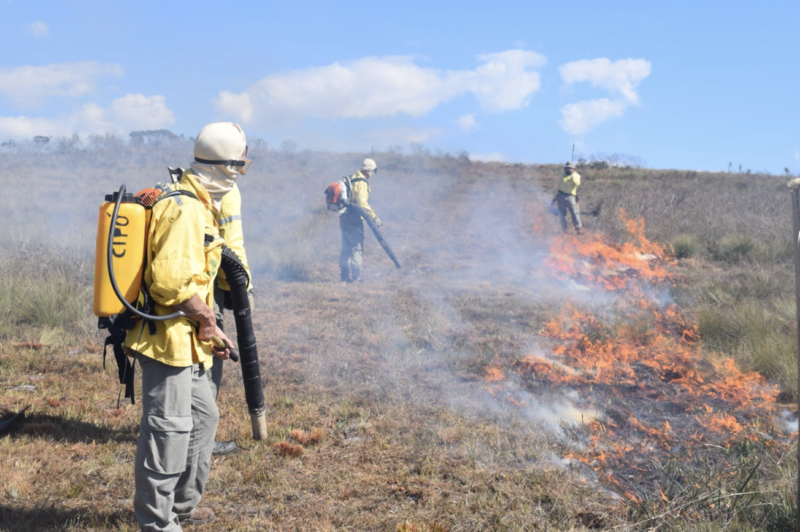Integrated fire management (IFM) is an approach that proposes the use of controlled burning at the beginning of drought periods and aims to reduce the conditions for the occurrence of large forest fires, ensuring the conservation and sustainable use of ecosystems. The IFM is made through the preparation of firebreaks, that is, bands of protection intended to cause the discontinuity of combustible material and, thus, to prevent the spread of the fire that could cause a forest fire.
The application of integrated fire management is carried out in strategic periods of the year, especially in times of onset of drought, under conditions of quality and quantity of fuel that are convenient for the purpose of controlled burning together with the conservation of biodiversity. Furthermore, before starting the burning, a study is carried out on the area, to assess the impact of the fire on the phytophysiognomy of the site. Another important tool in the use of IFM is the preparation of “black fires”, which consist of the pre-defined burning of a certain area, which aims to cause discontinuity of combustible material and thus prevent the spread of fire that could result in a forest fire. In order to carry out an IFM, the presence of a trained, qualified and equipped fire fighting brigade is required.
The Pilot Program for Integrated Fire Management (IFM) in Brazil began in June 2014. Initially this program was applied in three conservation units (CUs) of the Cerrado (a specific Brazilian biome), the Chapada das Mesas National Park, Jalapão State Park and the Serra Geral do Tocantins Ecological Station. The project aimed to implement controlled burning to prevent future fires from occurring, to control the spread of existing fires and so preserve different environments through the use of fire as a tool, in an attempt to reduce the areas susceptible to forest fires, as well as to restore and protect vegetation.
Much of the vegetation of the Cerrado has adaptations which create fire resistance, making the use of IFM useful for maintenance of the biome’s phytophysiognomy. The use of controlled fires at certain times of the year can be used to support the reproductive process of some plant species, benefiting the ripening of fruits and inducing flowering. Through integrated fire management, which involves controlled and infrequent burning, vegetation can be regenerated and grow more diverse.
Fire management is also essential for the management and maintenance of areas, including preventing the occurrence of fires resulting from arson which generally are associated with the practice of illegal agricultural activities.
Monitoring is also a key part necessary for the IFM to be implemented properly. The information collected through the monitoring strategies each year is essential for the fire management of the following year, since this monitoring identifies areas having accumulations of biomass, which require the prescribed burning.
In May 2021, World Environmental Conservancy (WEC) volunteers participated in a IFM in Serra do Cipó, Minas Gerais, Brazil. The Serra do Cipó National Park is a Brazilian conservation unit located in Serra do Espinhaço, in Minas Gerais. Created in September 1984, in the municipalities of Santana do Riacho, Morro do Pilar, Itambé do Mato Dentro and Jaboticatubas, the Park has a total area of 33.8 thousand hectares. Aiming at greater protection, in 1990, the federal government created an environmental protection area called the Morro da Pedreira Environmental Protection Area, which surrounds the entire park and protects an area of more than 100 thousand hectares.
The Park region is characterized by altitudes ranging from 900 to 1600 meters, which contributed to the origin of waterfalls and rapids in the region. The fauna and flora are extremely rich and diversified in this area, with several species that are at risk of extinction.
There were three days of fire application where, in addition to the IFM, validations were carried out for fire detection by satellites, meteorological observations, fire temperature measurements, etc. It was an excellent opportunity to increase familiarity with a topic that is so sensitive for Brazil forest fires.
Atlanta, September 21, 2021
By K.Silva, M.Romão and L.B.M.Pires
REFERENCES:
- Projeto Cerrado Jalapão. Programa Piloto de Manejo Integrado do Fogo é implementado em três Unidades de Conservação do Cerrado. 2014. Available at: http://cerradojalapao.mma.gov.br/noticias/programa-piloto-de-manejo-integrado-do-fogo-e-implementado-em-tres-unidades-de-conservacao-do-cerrado. Accessed in: 07 jun. 2021.
- CARVALHO, Lívia Moura. Implicações e aprendizados do manejo integrado do fogo no cerrado: estudo de caso no Parque Nacional da Chapada das Mesas (PNCM). 2018. Available at: https://repositorio.unb.br/handle/10482/33024. Accessed in: 07 jun. 2021.
- BORRALHO, Leonardo Almeida; MARTINS, Matheus Fernandes; BASTOS, Kurtis François Teixeira. O Manejo Integrado do Fogo como ferramenta legal e conservacionista em Unidades de Conservação. Available at: file:///C:/Users/kimbe/Downloads/1292-Texto%20do%20Artigo-5927-1-10-20191029%20(2).pdf. Accessed in: 05 jun. 2021.
- SILVA, Amanda Avelina Carvalho; VIDAL, Junia Maria Cota; SILVA, Ricardo Alexandre da; LACORTE, Gustavo Augusto. INCÊNDIOS FLORESTAIS NO PARQUE NACIONAL DA SERRA DA CANASTRA E A IMPLEMENTAÇÃO DE MANEJO INTEGRADO DO FOGO. 2018. Available at: http://www.forscience.ifmg.edu.br/forscience/index.php/forscience/article/view/404/2 17. Accessed in: 04 jun. 2021.
- FRANCISCO, Wagner de Cerqueira e. Ação do fogo no cerrado. Available at: https://brasilescola.uol.com.br/brasil/a-acao-fogo-no-cerrado.htm#:~:text=Por%C3% A9m%2C%20o%20fogo%20no%20cerrado,criando%20condi%C3%A7%C3%B5es %20favor%C3%A1veis%20para%20tal. Accessed in: 09 jun. 2021.
- CARVALHO, Livia Moura. Fogo no Parque Nacional da Serra da Canastra/MG: abordagem dos aspectos fisiográficos e humanos na concepção de uma proposta de Manejo Integrado de Fogo. 2013. Available at: https://repositorio.unesp.br/handle/11449/95544. Accessed in: 09 jun. 2021.
- Instituto sociedade população e natureza. Entenda a importância do manejo integrado do fogo para a natureza. 2020. Available at: https://ispn.org.br/entenda-a-importancia-do-manejo-integrado-do-fogo-para-a-nature za/. Accessed in: 19 maio 2021.
- Projeto Cerrado Jalapão. Conceito de Manejo Integrado do Fogo. Available at: http://cerradojalapao.mma.gov.br/mif. Accessed in: 18 maio 2021.

